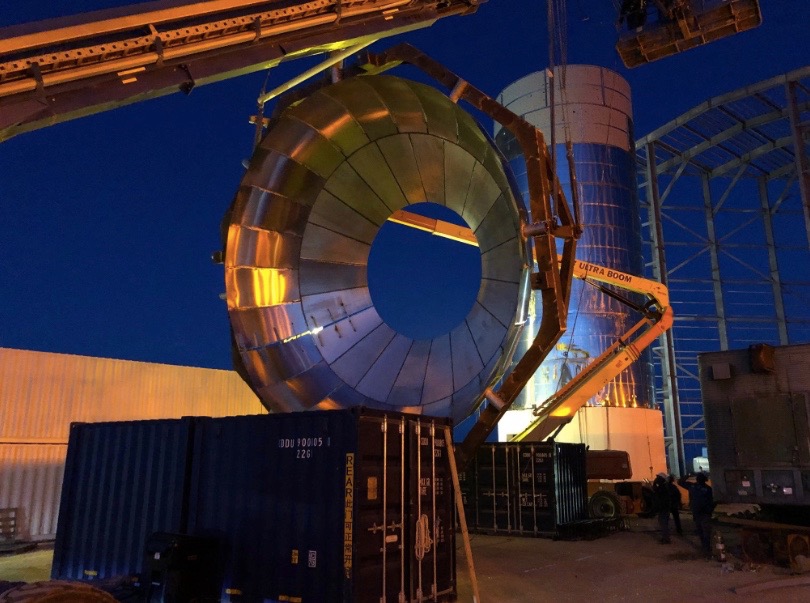
The first orbital prototype of SpaceX's Mars-colonizing Starship vehicle should be ready to fly soon, company founder and CEO Elon Musk said.
SpaceX is building two orbital Starship forerunners — a bit of intracompany competition intended to improve the design of the final spacecraft. The prototype known as Mk1 is coming together at the company's facility in Boca Chica, Texas, whereas Mk2 is being built on Florida's Space Coast.
The Mk1 and Mk2 craft are different from the stripped-down prototype known as Starhopper, which recently made its first untethered hop at Boca Chica. Starhopper has just one Raptor engine and will stay firmly within Earth's atmosphere throughout the testing phase. Mk1 and Mk2, on the other hand, will feature at least three Raptors and are designed to reach orbit, Musk has said.
Related: SpaceX's Starship and Super Heavy Mars Rocket in Pictures
Very convincing! Ok, Boca it is. We should have Starship Mk1 with 3 Raptors almost ready to fly by then.August 4, 2019
The finished, 100-passenger version of Starship will sport six Raptors. Super Heavy, the giant rocket that will launch Starship off Earth's surface, will have 35 of these next-generation engines, Musk said recently.
But we'll soon find out if those specs have changed. The billionaire entrepreneur announced via Twitter over the weekend that he'll provide a Starship design update on Aug. 24 at the Boca Chica facility. And Mk1's first flight could come quickly on the heels of that event, he added.
"Very convincing! Ok, Boca it is. We should have Starship Mk1 with 3 Raptors almost ready to fly by then," Musk tweeted on Aug. 3, responding to a follower who made the case for holding the event at Boca Chica. (Musk had previously said he'd provide the update from either Boca Chica or Cape Canaveral.)
Get the Space.com Newsletter
Breaking space news, the latest updates on rocket launches, skywatching events and more!
Two days later, he gave his Twitter followers an inside look at Mk1 construction, posting four photos of the unfinished prototype.
"Just left Starship Texas build site. Very proud of progress SpaceX team has made! Pics are of 9m dome rotation & Starship airframe behind windbreak," Musk tweeted Monday (Aug. 5).
He heaped similar praise that day on the Florida team building Mk2.
"Great progress by Starship Cape team. Started several months behind, but catching up fast. This will be a super fun race to orbit, moon & Mars!" Musk tweeted Monday.
Just left Starship Texas build site. Very proud of progress SpaceX team has made! Pics are of 9m dome rotation & Starship airframe behind windbreak. pic.twitter.com/1cmOzkPlknAugust 5, 2019
Both Starship and Super Heavy will be reusable. SpaceX envisions the system eventually shouldering the company's entire spaceflight burden, from launching satellites to taking people to and from the moon, Mars and other distant destinations. (SpaceX plans to phase out its existing flight hardware — the Falcon 9 and Falcon Heavy rockets, and the cargo and crew versions of the Dragon capsule, Musk has said.)
The first Starship-Super Heavy mission could come as early as 2021, SpaceX representatives have said. The first flights will likely loft commercial communications satellites. But a crew-carrying mission is on the docket for 2023: Japanese billionaire Yusaku Maezawa booked a trip around the moon for himself and a handful of artists.
- See the Evolution of SpaceX's Rockets in Pictures
- Will Elon Musk Fly on SpaceX's Private Moon Flight in 2023 with Japanese Billionaire?
- SpaceX's Raptor Engine Hits Power Level for Starship Launches
Mike Wall's book about the search for alien life, "Out There" (Grand Central Publishing, 2018; illustrated by Karl Tate), is out now. Follow him on Twitter @michaeldwall. Follow us on Twitter @Spacedotcom or Facebook.
Join our Space Forums to keep talking space on the latest missions, night sky and more! And if you have a news tip, correction or comment, let us know at: community@space.com.

Michael Wall is a Senior Space Writer with Space.com and joined the team in 2010. He primarily covers exoplanets, spaceflight and military space, but has been known to dabble in the space art beat. His book about the search for alien life, "Out There," was published on Nov. 13, 2018. Before becoming a science writer, Michael worked as a herpetologist and wildlife biologist. He has a Ph.D. in evolutionary biology from the University of Sydney, Australia, a bachelor's degree from the University of Arizona, and a graduate certificate in science writing from the University of California, Santa Cruz. To find out what his latest project is, you can follow Michael on Twitter.









